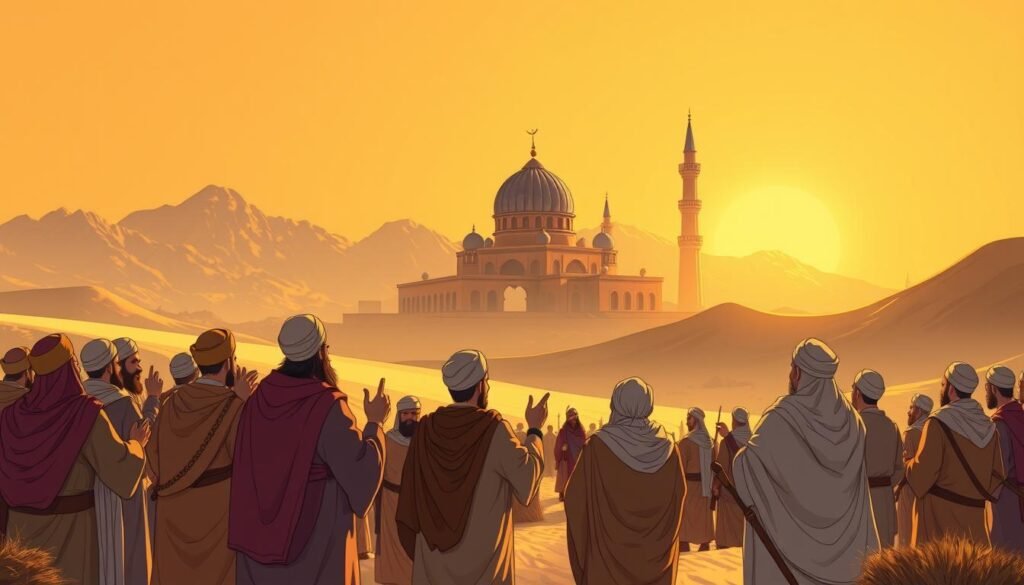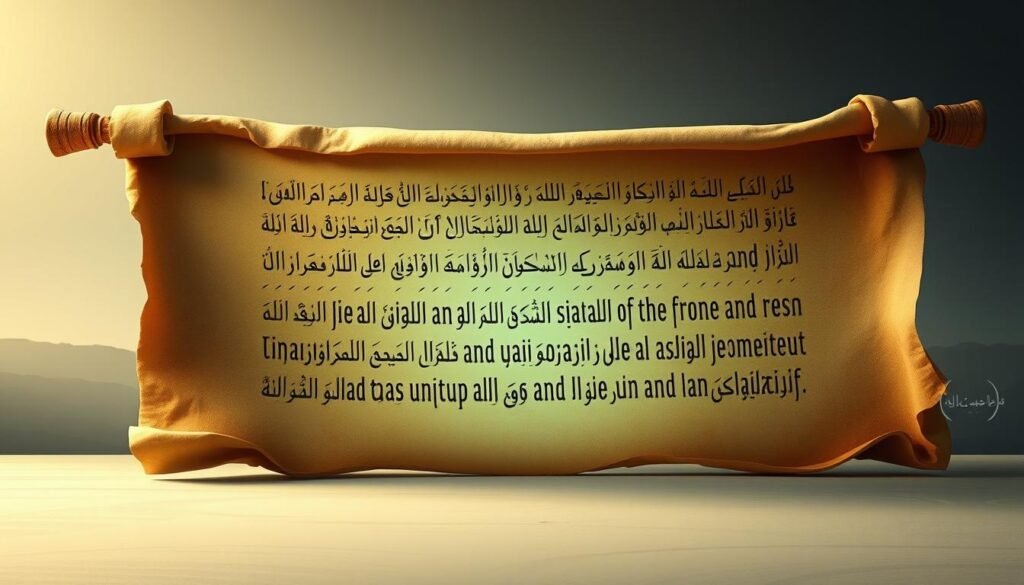Have you ever thought about how one message can lead to so many different views? The hadith about 73 sects shows us this isn’t a new problem. The Prophet Muhammad said: “My Ummah will split into 73 sects—only one will enter Paradise.” These words remind us to think: What does it mean to follow the “saved path” today?
Imagine you’re at a crossroads. The numbers tell a story: 73 Islamic sects versus 71 Jewish and 72 Christian groups. But the Prophet’s warning is more than just counting groups. It’s a call to avoid pride that divides us. How can we respect our differences without losing our shared values?
As I explore this hadith, I see its timeless importance. The Prophet’s words about unity stand out against today’s social media fights where “sect” is used as a weapon. The saved group isn’t just a label but a way of thinking based on mercy and community—Al-Jama’ah, the mainstream path shown by the Prophet’s Companions.
Think about this: The Quran tells us to seek “righteousness and fear of Allah” (Surah al-An’am 6:153). The hadith’s numbers show that even one right path needs humility. When we fight over small differences, aren’t we risking being among the 72 stray groups?
What would the Prophet’s companions say to today’s divided Muslim communities? Let’s see division as a chance to reflect on our choices. This article asks: Can we bring back the Prophet’s vision of unity while respecting our differences? The answer is in going back to the teachings that unite us.
Understanding the Hadith About 73 Sects
The hadith about the Prophet’s warning of division is at the heart of debates on Islamic unity. We will look at its wording, origins, and scholarly debates. This will help us understand its message clearly.
“My Ummah will split into 73 sects: one will enter Paradise and 72 will enter Hell. The saved group is al-Jamā’ah—the majority following me and my Companions.”
Original Text and Translation
The hadith is found in Sunan Ibn Majah and Abu Dawud, with slight variations. Yet, its core message is clear: a division between one saved path and 72 deviant groups. The term “saved sect” (saved sect) points to the mainstream group following early Islamic consensus.
Scholars like Ibn Taymiyyah saw it as a literal warning against division. They stressed the importance of sticking together.
Context of When It Was Spoken
This warning was given during the Prophet’s final days. It was a message about future Islamic sectarianism. At that time, Muslims were united, but the Prophet foresaw divisions after his death.
The comparison with Jews and Christians shows a divine pattern. It suggests that human communities naturally split, but only one path is true.
Chain of Narration and Authentication
Some scholars, like Ibn Hazm, questioned its chain of narration. Yet, most Sunni authorities, including Ibn Al-Qayyim, believe it’s authentic. Hadith authentication debates continue, but most agree it’s valid.
Modern scholars like Al-Albani found it “weak” individually. But, its collective acceptance is strong due to multiple narrations.
Historical Background of Sectarianism in Early Islam
To understand early Islamic sects, we must look at the early disagreements. These debates started after the Prophet passed away. They were about who should lead, leading to the Sunni Shia division.
Supporters of Abu Bakr, Umar, and Ali each thought they were right. This led to groups that later became different schools of thought.

Political Divisions Sparking Theological Shifts
The death of Caliph Uthman in 656 CE made things worse. Sunnis think Ali was a good leader, but Shias believe he was not. This disagreement led to the Kharijites, a group that even Ali’s followers didn’t agree with.
The Umayyad dynasty’s rise made things even more complicated. It mixed politics with beliefs, making things harder to understand.
Emergence of Doctrinal Fault Lines
Islamic theological differences grew as people argued about the Quran. They debated free will versus destiny, who should lead, and what justice means. This split people into groups like the Qadariyyah and Jabriyyah.
Later, the Mu’tazilites and Ash’arites argued over reason versus tradition. These debates were important because they decided who was part of the “saved sect.”
Symbolic Numbers and Sectarian Realities
“The figure ‘seventy’ in Arabic also means ‘several’—a metaphor for fragmentation, not exact counts.”
Al-Bukhari said the hadith was meant to be symbolic. But, Muslim sectarian history shows how politics turned into beliefs. Today, we wonder if our differences come from history or faith.
The story of early Islamic theological differences teaches us about the importance of unity. We must look at our differences with humility.
Scholarly Interpretations Through the Centuries
Historical Islamic scholarship shows debates by scholars like Ibn Taymiyyah and al-Baghdadi. They discussed the interpretations of 73 sects hadith. Their works, like Al-Farq bayn al-Firaq, tried to set clear boundaries. But, their views differed.
Mystics like Rumi believed in spiritual unity. They said being sincere is more important than being part of a group. Modern scholars, like Dr. Shadee Elmasry, see the Jama’ah meaning as the majority following key principles, not just numbers.
“The Muslim community’s mainstream remains the true jama’ah—those upholding essential beliefs like the Quran’s oneness and prophethood,”
say today’sIslamic scholars on sectarianism. This view is different from strict lists of sects. Yasir Qadhi points out that new groups form every day, making strict counts hard.
Early debates also questioned the hadith’s truth. Ibn Hazm thought some stories were weak. Others saw them as metaphors.
The term “jama’ah” means different things to different people. It could mean following a school like Hanafi or a Sufi path. Al-Ghazali said we should focus on being ethical together, not just on what we believe.
This view matches Quranic verses that celebrate diversity (Quran 5:48). Today, historical Islamic scholarship teaches us that labels change over time. The hadith warns against division, urging us to focus on what really matters: justice, mercy, and unity.
In our world today, this message is just as relevant. It tells us that unity is not about ignoring our differences. It’s about finding common ground and working together.
Does the Hadith Predict Division or Warn Against It?
At the heart of the debate is the hadith’s purpose—is it a cautionary prophecy urging unity or a prediction of division? Early scholars like hadith critics saw its intent as a warning. The Islamic unity hadith teaches us to “hold fast to the Rope of Allah” together. It warns that division weakens us.
The term Firqat an-Nājiyah (the Saved Sect) refers to those who hold to core principles. This is explained in Taha Jabir Al-Alwani’s 2024 book Preserving Unity and Avoiding Division (ISBN 979-8-89193-050-6).
“Allah commands us with unity upon the truth,” said Shaikh Sālih Al-Fawzān. He agrees with the hadith’s call to reject division. This warning against division in Islam asks us to reflect on ourselves, not judge others.
Modern scholars see the hadith’s 73 sects as symbolic, not literal. The Prophet emphasized Firqat an-Nājiyah as what he and his Companions followed. Al-Alwani’s work shows how sectarianism distorts this message, turning disagreements into deep divisions.
The cautionary prophecy reminds us that unity needs humility. It warns against blind conformity and divisive arguments.

Early Muslims debated differences constructively, but later, disagreements turned into permanent divisions. The hadith’s true purpose is clear: it’s a call to vigilance, not a prediction of fracture. By focusing on justice and compassion, we honor the Prophet’s vision of a unified Ummah. Let’s ask: are we preserving unity through dialogue or deepening divisions?
Common Misconceptions About the 73 Sects Hadith
Many people today get the 73 sects hadith wrong. They let misinterpretations of 73 sects hadith lead to sectarian exclusivism. This idea that only one group can be saved causes division. It ignores the hadith’s warning against being too rigid.
Dr. Shadee Elmasry says such claims start cycles of hatred. Groups “cannibalize and hate one another and divide.”
The number 73 is often seen as exact, but symbolic numbers in hadith teach a bigger lesson. The number 70+ means “many,” not a specific count. Focusing on “exactly 73” misses the point of unity over division.
Even Shia and Sunni agree the hadith warns against splitting into too many groups. It’s not about counting exactly 73.
“The division into sects is emphasized with a 100% prediction of the 72 sects facing punishment, while only 1 sect (approximately 1.37% of the total) is considered saved.” Quranic principles stress mercy, yet this hadith’s message is twisted to justify exclusion.
True Islamic diversity is about sticking to core beliefs and accepting different ways of understanding. The “saved sect” means those who follow the Prophet’s teachings, not just one group today. My research shows that claims of exclusivity go against the hadith’s call for unity.
We must focus on the basics of our faith, not on labels that divide us. This way, the ummah can stay united.
Modern Muslim Diversity and the 73 Sects Perspective
Today, Islam is diverse and changing, not split as the hadith warned. Muslims now range from very traditional to quite modern. Yet, they all agree on key things like the Shahada and the Five Pillars.
The hadith talks about 73 sects, but it’s not a strict guide. It’s a call to stick together on the basics. Dr. Shadee Elmasry says the saved group is those who share values like justice and kindness.
When we look at hadith today, we must mix old traditions with new contexts. Ibn Taymiyyah said we shouldn’t call others wrong easily. He said most Muslims are on the right path, guided by the Quran and Sunnah.
The strength of Islam comes from its ability to handle differences. But, conflicts in the Middle East show how wrong labels can hurt us more than disagreements.
Divisions among Jews and Christians are also mentioned in hadiths. But, the Prophet said 70,000 believers will go to Paradise without being judged. This shows God’s mercy, not strict rules.
Today, we need to talk openly and respect our differences. By focusing on being true (ikhlas) and not just labels, we follow the Quran. The story of 73 sects can teach us to be humble, not divided.
FAQ
What does the hadith about the 73 sects mean for contemporary Muslims?
Why is understanding the context of the hadith important?
How do scholars interpret the term "the saved sect" mentioned in the hadith?
What are common misconceptions about the 73 sects hadith?
How does the concept of sectarianism relate to the hadith?
Why is the number 73 not meant to be taken literally?
How can contemporary Muslims balance doctrinal integrity with inclusivity?
How does the modern diversity of the Muslim community relate to the hadith?

Embracing Faith, One Insight at a Time!
The teachings of the Quran have always guided my path. With a deep passion for Islamic knowledge, I strive to blend the wisdom of tradition with the relevance of today, making the timeless messages of Islam accessible and meaningful for everyone.
Muslim Culture Hub is my platform to share historical insights and thought-provoking articles, exploring both well-known and lesser-discussed aspects of Islamic culture and beliefs. My mission is to create an inclusive online space where everyone can learn, strengthen their faith, and connect with the profound message of Islam.
Join the journey!
May peace be upon you.







